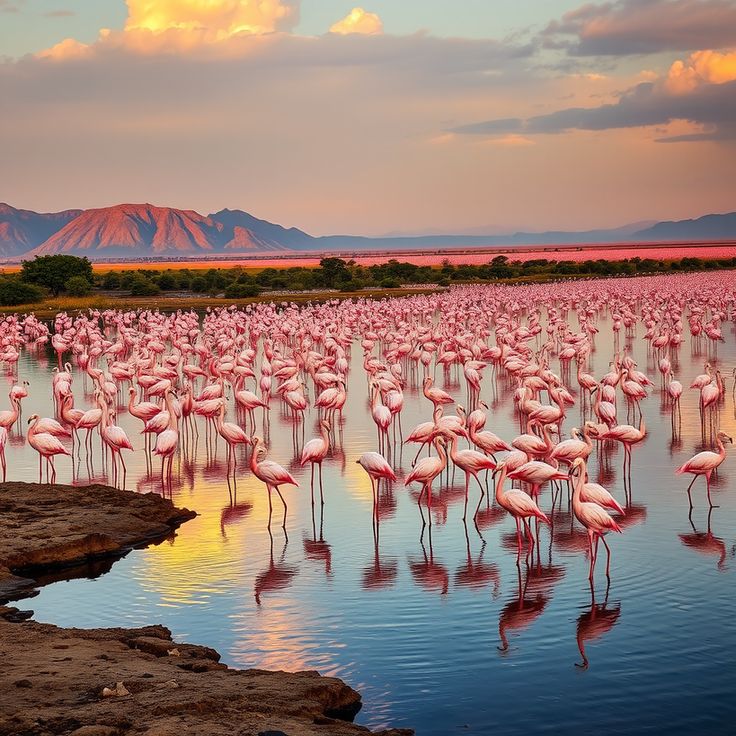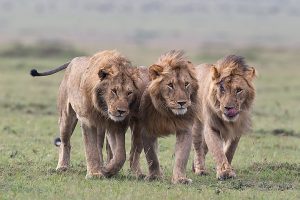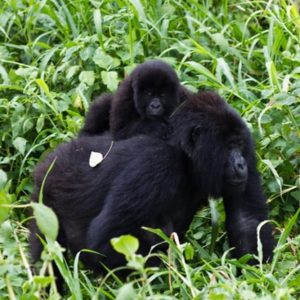Lake Nakuru National Park in Kenya is one of Africa’s most renowned bird-watching destinations. Nestled in the Great Rift Valley, this alkaline lake and its surrounding ecosystems attract hundreds of bird species, making it a paradise for ornithologists, nature enthusiasts, and photographers. From the famous flamingos that turn the lake pink to migratory species arriving from across the globe, Lake Nakuru offers an unparalleled bird-watching experience.
Why is Lake Nakuru famous for bird watching?
Lake Nakuru is famous for bird watching because of its diverse ecosystem that supports over 400 recorded bird species. Its alkaline waters and surrounding wetlands create ideal feeding and breeding grounds for flamingos, pelicans, storks, and many other water birds.
The lake gained international recognition as the “bird watcher’s paradise” largely due to the spectacular flocks of flamingos that once numbered in the millions. Although their numbers vary depending on water conditions, Lake Nakuru remains one of the best places in the world to observe flamingos and numerous other waterfowl.
How many bird species are found in Lake Nakuru National Park?
Lake Nakuru National Park is home to more than 400 bird species, making it one of the most significant birding destinations in East Africa. Among them are 50 species of water birds, numerous migratory species, and several raptors.
Key species include:
- Flamingos (lesser and greater)
- Pelicans (great white pelican and pink-backed pelican)
- Cormorants and herons
- Marabou storks, ibises, and spoonbills
- Fish eagles, hawk eagles, and vultures
- Migratory birds such as European storks and swallows
This diversity ensures that bird watchers have rewarding sightings throughout the year.
When is the best time to see flamingos at Lake Nakuru?
The best time to see flamingos at Lake Nakuru is during the dry season from June to March, when water levels in the lake are stable and conditions favor the growth of cyanobacteria (blue-green algae), the primary food source for flamingos.
In wetter months, fluctuating water levels may cause flamingos to migrate to nearby lakes such as Lake Bogoria or Lake Elementaita. However, Lake Nakuru usually retains some flamingos year-round, along with many other water bird species.
Are there still flamingos at Lake Nakuru?
Yes, there are still flamingos at Lake Nakuru, though their population has decreased compared to past decades. Changes in water salinity, rising water levels, and ecological shifts have influenced flamingo migration patterns. Today, visitors may see thousands rather than millions of flamingos, but the sight remains spectacular.
Even when flamingo numbers decline, Lake Nakuru remains a vital bird watching destination due to its variety of pelicans, storks, raptors, and migratory birds.
What other birds can be seen at Lake Nakuru besides flamingos?
Bird watchers at Lake Nakuru can see a wide variety of species beyond flamingos. These include:
- Great white pelicans – often seen scooping fish in groups.
- African fish eagles – soaring over the lake with their iconic calls.
- Cormorants – commonly perched on fallen trees near the lake shore.
- Goliath herons – the world’s largest heron species.
- Secretary birds – known for their snake-hunting skills.
- Migratory birds – such as storks, terns, and swallows during certain seasons.
This diversity ensures that bird watching is rewarding throughout the year, regardless of flamingo numbers.
What equipment is needed for bird watching at Lake Nakuru?
For an optimal bird watching experience at Lake Nakuru, visitors should carry:
- Binoculars – essential for spotting distant birds along the lake shore.
- Camera with telephoto lens – for capturing detailed bird photography.
- Bird identification guidebook – to help recognize species.
- Comfortable walking shoes – for exploring trails and viewpoints.
- Field notebook – to record sightings.
Equipped with these essentials, bird watchers can fully enjoy the diversity of species the park offers.
Can you see migratory birds at Lake Nakuru?
Yes, Lake Nakuru attracts migratory birds, particularly from November to April. During this period, species from Europe and Asia fly south to escape harsh winters. Notable migratory birds include European storks, steppe eagles, and swallows.
The presence of these birds enhances the variety of species visible in the park, making the migratory season one of the most rewarding times for bird watching.
Where are the best bird watching spots inside Lake Nakuru National Park?
Some of the best bird watching spots inside Lake Nakuru National Park include:
- Baboon Cliff – offering panoramic views of the lake and flocks of flamingos.
- Makalia Falls – a scenic area where water birds gather.
- The shoreline viewpoints – excellent for spotting pelicans, cormorants, and herons.
- Outlook points near Lion Hill – ideal for observing raptors and migratory species.
These vantage points combine scenic beauty with exceptional bird viewing opportunities.
How much is the entry fee to Lake Nakuru National Park for bird watchers?
Entry fees to Lake Nakuru National Park are managed by the Kenya Wildlife Service (KWS) and vary by residency status:
- Kenyan Citizens: Adults KES 860, Children KES 215
- Residents: Adults KES 1,030, Children KES 515
- Non-Residents (Tourists): Adults USD 60, Children USD 35
Fees allow full-day access to the park for bird watching, game drives, and sightseeing. Payments can be made via M-Pesa, credit card, or other KWS-approved methods.
What wildlife other than birds can be seen at Lake Nakuru?
In addition to bird watching, Lake Nakuru National Park is home to a variety of wildlife. Visitors often spot:
- White and black rhinos – the park is a rhino sanctuary.
- Rothschild’s giraffes – a rare subspecies protected in the park.
- Lions and leopards – occasionally seen during game drives.
- Buffalo, waterbuck, and antelope – grazing along the shore.
The combination of birds and big game makes Lake Nakuru a comprehensive safari experience.
Why do flamingos gather at Lake Nakuru?
Flamingos gather at Lake Nakuru because of its alkaline waters rich in cyanobacteria, which provide their main source of food. The lake’s shallow depth and expansive shoreline make it ideal for feeding.
Seasonal changes in water salinity, algae levels, and climate influence flamingo presence. When conditions shift, flamingos may migrate to neighboring Rift Valley lakes, but Lake Nakuru remains an important feeding and breeding ground.
Is Lake Nakuru good for bird photography?
Lake Nakuru is excellent for bird photography due to its vast flocks of flamingos, pelicans, and raptors, as well as its dramatic backdrops of cliffs and savannah. The proximity of birds to the shoreline allows photographers to capture detailed shots without disturbing them.
Morning and evening light offer the best conditions for photography, with reflections on the lake creating striking images. A camera with a zoom or telephoto lens is highly recommended.
How do you get to Lake Nakuru from Nairobi for bird watching?
Lake Nakuru is located about 160 kilometers northwest of Nairobi, making it a convenient destination for bird watchers. Travel options include:
- By car – a 2.5 to 3-hour drive via the Nairobi–Nakuru highway.
- By public transport – matatus and buses operate from Nairobi to Nakuru town, with taxis available to the park.
- By tour operator – many safari companies offer guided bird watching tours to the park.
The main entry points are Main Gate and Lanet Gate, both accessible from Nakuru town.
What makes Lake Nakuru important for bird conservation?
Lake Nakuru is recognized as a Ramsar wetland of international importance and a UNESCO World Heritage Site (as part of the Kenya Lake System). It provides crucial feeding, breeding, and stopover habitats for both resident and migratory bird species.
Conservation efforts within the park focus on protecting bird habitats, controlling invasive plant species, and managing fluctuating water levels that affect flamingo populations. Its role in regional and global bird migration makes it one of Africa’s key bird conservation areas.
Can bird watching at Lake Nakuru be combined with game drives?
Yes, bird watching at Lake Nakuru can easily be combined with game drives. Visitors often spot birds while driving through the park’s varied habitats, which include woodlands, grasslands, and wetlands.
This dual experience makes Lake Nakuru ideal for safari-goers who want to enjoy both avian diversity and Africa’s iconic mammals. Many guided tours include a mix of bird watching and wildlife viewing for a well-rounded experience.
Final Thoughts
Bird watching at Lake Nakuru National Park is one of the most rewarding experiences for nature lovers. With over 400 bird species, including flamingos, pelicans, raptors, and migratory birds, the park offers exceptional diversity year-round. Combined with rhinos, giraffes, and other wildlife, Lake Nakuru delivers a unique blend of birding and safari adventure.
Whether you are an avid birder, a photographer, or simply a traveler seeking natural beauty, Lake Nakuru remains one of Kenya’s most iconic destinations for bird watching




